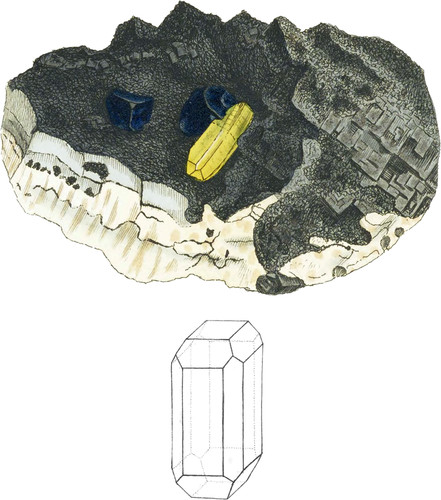 Enlarge
Enlarge
British Mineralogy
Carbono-muriate of Lead
- Class 3. Metals.
- Ord.
- Gen. Lead.
- Spec. Carbono-muriate.
- Syn. A New Variety of Lead Ore. Chenevix in Nicholson’s 4to Journal. 4. 219. Klaproth’s Analyses, vol. 3.
I feel highly gratified in the opportunity of elucidating this rare substance, which does not seem to have been known to be found, excepting in this country in the neighbourhood of Cromford Levels near Matlock, Derbyshire. It was first discovered to be a new mineral by the discerning Count de Bournon, who has a primitive crystal of it, and many excellent sketches and memorandums made from our late good friend the Hon. Charles Greville’s superb collection, which is now happily secured to this country in the British Museum, and from which we have selected the best specimens for these figures.
The crystal is a rectangular prism, whose planes are parallel to the nucleus, sometimes having a cubical proportion, with the angles replaced by isosceles triangular planes, the incidence or which upon the terminal face is 122°. See the blueish figures on the left of the yellow crystal, which look like regular cubo-octaëdrons. In these the columnar edges are a little rounded by small faces, which in some crystals are so much enlarged as almost to obliterate the primitive ones. The yellowish lengthened crystal has the first of these faces enlarged so as lo form a four-sided pyramid, with only a minute vestige of the terminal primitive plane, and the edges of the prism replaced by truncating planes larger than the portion they leave of the original faces.
This substance has generally a glassy or gem-like lustre, is softer than Carbonate of Lead, which will scratch it, and with which it has been confounded. It is accompanied by small crystals of dull purplish Cubic Fluor, nearly in form of a line above them; and Galæna or Sulphuret of Lead on the right, and which is distinguished by its square appearance. The whole on opaque Sulphate of Barytes, commonly called Cawk in Derbyshire; and there are some small crystals or Carbonate of Lead scattered about it.
According to Mr. Greville, it was about the year 1785 that this curious local substance was found; and the works being discontinued, there are very few specimens known. The outline or geometrical figure explains the form of the columnar crystal, and agrees nearly with some other specimens which terminate with a flat apex.

